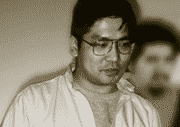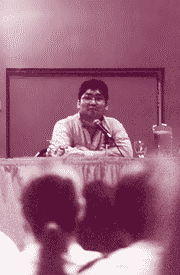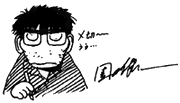
|
 —EX Staff Report
Sonoda Kenichi is a name familiar to many anime fans. If you joined the
ranks of anime fandom in the late 1980s or in the 1990s, one of the
catalysts of your decision was probably the smash hit
BUBBLEGUM CRISIS. Serving as character designer on
this epic series is perhaps what catapulted him to fame, certainly at least
in American circles. Since then, he has gone on to work on the fan
favorites OTAKU NO VIDEO,
RIDING BEAN, and of course,
the manga series GUNSMITH CATS.
EX: BUBBLEGUM CRISIS is
still introducing anime fans to your art here in America. When you look back
at the series, what aspects do you find the most appealing?
EX: What was the most
challenging aspect of working on BGC? |
|||
  |
EX: What were some of the difficulties in turning the GUNSMITH CATS manga into an anime OVA series? Sonoda: What was difficult was that I regret that a lot of my ideas and thoughts about what GUNSMITH CATS actually is were not reflected in the anime. I wasn't really involved with the production of the GSC anime so I can't really comment on this question.
EX: The City of Chicago
served as a backdrop for both RIDING BEAN and
GUNSMITH CATS and several years ago, you came here
to tour the city and research it in-depth for your work. How does it feel
to be back in Chicago and have you gotten a chance to see how much it's
changed since your last visit?
EX: How do you think
your art style has changed since your earlier works?
EX: Where do you find
inspiration for your characters?
EX: What do you think
is the most important attribute for a manga artist to have?
EX: Whom do you think
has influenced your work?
EX: As a youth, how did
your interest in manga begin?
EX: Do you think that
American fan artists are anywhere near the level of artistry that manga
artists have in Japan?
EX: With computers
becoming more and more prevalent in usage with both anime
(i.e. GHOST IN THE SHELL) and manga (Inoue
Takehiko's BUZZER BEATER being published on the
Internet), do you welcome the new technology or loathe it? |
|||
 |
EX: Wrapping up, what's next for you? Is there anybody in the future that you'd like to work with? Sonoda: Unfortunately, a deal to work with Madhouse and Kawajiri Yoshiaki on an original product fell through. But I do have another project in the works... (laughs) Photography by Dana Weaver |
 |